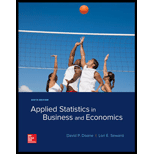
a.
Find the hypotheses in a chi-square test for independence.
a.
Explanation of Solution
The test hypotheses are given below:
Null hypothesis:
Alternative hypothesis:
b.
Explain why it is known as test of frequencies.
b.
Explanation of Solution
The chi-square test for independence is a test based on frequencies. Thus, it is known as test of frequencies.
c.
Find the distribution that is used in this test.
c.
Explanation of Solution
In chi-square test for independence, the shape of the population from which the sample has taken is not specified. Therefore it called distribution free test.
d.
Find the degrees of freedom for a
d.
Explanation of Solution
The degrees of freedom for a
Want to see more full solutions like this?
Chapter 15 Solutions
APPLIED STAT.IN BUS.+ECONOMICS
- Mean Height of Men A formal hypothesis test is to be conducted using the claim that the mean height of men is equal to 174.1 cm. a. What is the null hypothesis, and how is it denoted? b. What is the alternative hypothesis, and how is it denoted? c. What are the possible conclusions that can be made about the null hypothesis? d. Is it possible to conclude that “there is sufficient evidence to support the claim that the mean height of men is equal to 174.1 cm”?arrow_forwarda) Does the "mean" of the sampling means always equal to that of the population mean? Discuss b) As the size of the sample increases, the sampling distribution of the sample means is approximately normal. Why? Explain c. What is the Central Limit Theorem? How large should the sample size be if the underlying distribution of the population values are: i) Normally distributed (discuss). ii) Non-normally distributed. (discuss)arrow_forwardSignificance Levels Test A is described in a journal article as being significant with "P<0.01"; Test B in the same article is described as being significant with "P=0.10". Using only this information, which test would you suspect provides stronger evidence for its alternative hypothesis?arrow_forward
- What is the null hypothesis for a chi-square test? Two variables are related in the sample Two variables are related in the population Two variables are unrelated in the sample ( don't hand writing solution)arrow_forwardA researcher obtains a negative value for the chi-square statistic in a chi-square goodness of fit test. What can a researcher conclude based on this result? choices: The observed frequencies are consistently larger than the expected frequencies. The expected frequencies are consistently larger than the observed frequencies. There are large differences between the observed and expected frequencies. The researcher made a mistake because a chi-square value cannot be negative.arrow_forwardChi-square test for independence: The number of people who survived the titanic based on class and sex is collected and attached. Is there enough evidence to show that the class and the sex of a person who survived the titanic are independent? What is the null and alternative hypothesis?arrow_forward
- Cybersecurity The table below lists leading digits of 317 inter-arrival Internet traffic times for a computer, along with the frequencies of leading digits expected with Benford’s law (from Table 11-1 in the Chapter Problem). a. Identify the notation used for observed and expected values. b. Identify the observed and expected values for the leading digit of 2. c. Use the results from part (b) to find the contribution to the x2 test statistic from the category representing the leading digit of 2.arrow_forwardThe degrees of freedom for a 4 x 3 cross-tabulation table for the chi-square test of independence equal 4 3 6 5arrow_forwardQuestionConsider again the random sample as in item (3) above. Can you think of a suitable extension of the method-of-moment method to find an estimator of θ?arrow_forward
- Nonparametric Tests a. Which of the following terms is sometimes used instead of “nonparametric test normality test; abnormality test; distribution-free test; last testament; test of patience? b. Why is the term that is the answer to part (a) better than “nonparametric test”?arrow_forwardProfessor Ramos is going to the store and buys a bag of candy skittles. The company that manufactured the skittles claims that there is a certain proportion of specific colored candies. To test this claim, Ramos opens the bag and is about to test a hypothesis to find out if there is enough evidence to support the claim by the manufacture of candy skittles. Which type of hypothesis test is Ramos going to perform and why? A Goodness of fit test or a Chi-Square for Independence? Make sure to explain thoroughly your thoughts. What leads you to believe Ramos will use the hypothesis test you have in mind?arrow_forward(a) A two-tailed test of a one-sample hypothesis of a mean yields a test statistic of z = 1.47. What is the p-value? (b) A one-tailed test of a two-sample hypothesis involving the difference of sample means yields t = 1.85, with 12 degrees of freedom. What is the p-value?arrow_forward
 MATLAB: An Introduction with ApplicationsStatisticsISBN:9781119256830Author:Amos GilatPublisher:John Wiley & Sons Inc
MATLAB: An Introduction with ApplicationsStatisticsISBN:9781119256830Author:Amos GilatPublisher:John Wiley & Sons Inc Probability and Statistics for Engineering and th...StatisticsISBN:9781305251809Author:Jay L. DevorePublisher:Cengage Learning
Probability and Statistics for Engineering and th...StatisticsISBN:9781305251809Author:Jay L. DevorePublisher:Cengage Learning Statistics for The Behavioral Sciences (MindTap C...StatisticsISBN:9781305504912Author:Frederick J Gravetter, Larry B. WallnauPublisher:Cengage Learning
Statistics for The Behavioral Sciences (MindTap C...StatisticsISBN:9781305504912Author:Frederick J Gravetter, Larry B. WallnauPublisher:Cengage Learning Elementary Statistics: Picturing the World (7th E...StatisticsISBN:9780134683416Author:Ron Larson, Betsy FarberPublisher:PEARSON
Elementary Statistics: Picturing the World (7th E...StatisticsISBN:9780134683416Author:Ron Larson, Betsy FarberPublisher:PEARSON The Basic Practice of StatisticsStatisticsISBN:9781319042578Author:David S. Moore, William I. Notz, Michael A. FlignerPublisher:W. H. Freeman
The Basic Practice of StatisticsStatisticsISBN:9781319042578Author:David S. Moore, William I. Notz, Michael A. FlignerPublisher:W. H. Freeman Introduction to the Practice of StatisticsStatisticsISBN:9781319013387Author:David S. Moore, George P. McCabe, Bruce A. CraigPublisher:W. H. Freeman
Introduction to the Practice of StatisticsStatisticsISBN:9781319013387Author:David S. Moore, George P. McCabe, Bruce A. CraigPublisher:W. H. Freeman





